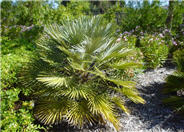
Common name:Mediterranean Fan palm
Botanical name:Chamaerops humilis
Slow growing to 20' tall but very hardy, the Mediterranean Fan palm is clump forming with rich green foliage. It can be used as a good container subject. It does best in full sun or partial shade. Petioles have sharp spines.
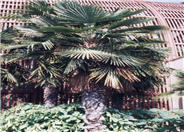
Common name:Windmill Palm, Hemp Palm
Botanical name:Trachycarpus fortunei
This easy-to-grow palm of medium height will mature to a size of 30' tall, and its slender trunk is covered with dense, heavy fiber topped with a crown of rich green, fan-shaped leaves.
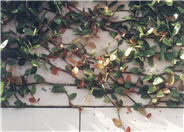
Common name:Creeping Fig
Botanical name:Ficus pumila
This is one of the few plants that can attach itself securely to wood, masonry, or metal. Because there is no limit to its size, it can overcome an entire buliding. It is most often found in colder climates. This vine will not climb on the south or west walls.
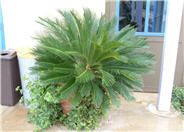
Common name:Sago-Palm
Botanical name:Cycas revoluta
Sago Palm resembles small palms; it is evergreen. It can slowly grow to 10'. It is used for a tropical effect and also looks great in planters. In the low desert, light shade and additional moisture are best. Side sprouts can form multi-trunked individuals. Apply fertilizer at leaf expansion. This plant has few pests.
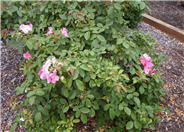
Common name:Shrub Rose
Botanical name:Rosa Shrub varieties
The dark green, heavily veined leaves of this bushy shrub are strong support for the pure white or pink, nearly double flowers it produces. This is a very tolerant, heavily scented plant with an impressive fall color. Also, large hips appear intermittently with this plant.
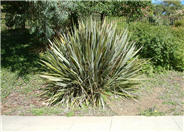
Common name:New Zealand Flax
Botanical name:Phormium tenax
New Zealand Flax is a large, bold plant with stiffly vertical, sword-like, green leaves that arise from its base. It should be grown under full sun for best color. Varieties will offer different growth habits and leaf color.
| Designer: Anon | Palm Garden |
Photographer: GardenSoft |
Soils and Compost:
Physical weed control, including mulching, or hand removal protects the watershed from harmful chemicals.
Water Saving Tip:
Apply a layer of mulch around plants to reduce moisture loss.
Choose organic mulches, such as shredded bark, compost or aged sawdust.
Integrated Pest Management:
Attract, or buy beneficial insects such as ladybugs and lacewings to control pest outbreaks in your garden.

